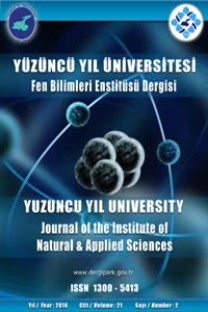Lactobacillus Brevis Mikroorganizmasının Çoğalma Kinetiğinin Cevap Yüzeyi Yöntemi ile İncelenmesi
Cevap Yüzey Yöntemi (CYY), Lactobasillus Brevis, Merkezi Kompozit Tasarım (MKT), Optimizasyon
Investigation of Growth Kinetics of Lactobacillus Brevis Microorganism by Response Surface Methodology (RSM)
___
- Aktaş, N., 2003. Akıskan yatak biyofilm reaktörde (AYBR) peyniraltı atık suyunun arıtılması ve sistem performansının modellenmesi. Doktora tezi, Hacettepe Üniversitesi, Fen Bilimleri Enstitüsü, Ankara.
- Aktaş, N., 2005. Optimization of biopolymerization rate by response surface methodology Uslu,G,. 1999. Kurşun (II),Kadmiyum(II), Bakır (II) (RSM) , Enzyme and microbial technology 37: 441-447.
- Fredrickson, J., Zachara, J., Balkwill, D., 2004. Geomicrobiology of high-level nuclear waste contaminated vadose sediments at the Hanford site. Washington state.
- Johnson, M., Lucey, J., 2006. Major technological advances and trends in cheese. Journal of Dairy Science, 89 (4): 1174–8.
- Kanta., 2002. Bira bozulma bakteri ve hop direnç Lactobacillius brevis.Groningen Üniversitesi, Bölüm 1, S 5-6.
- Marcobal, A., Martinez Alvarez, P.J., Po, M.C, Munoz, R., & Moreno Arribas, M.V., 2006. Formation of biogenicanimes throught the industrial manufacture of red wine. J.Food Prot., 69, 391-396.
- Myers, R.H., Montgomery, D.C, 2002. Response Surface Methodology, Process and Product Optimization Using Designed Experiments. Second Edition.
- Özçelik, A., 1996. ‘‘Genel Mikrobiyoloji’’. Süleyman Demirel Üniv. Ziraat Fak. Isparta.
- Şahan, T., 2008. Atık sularda bulunan bazı ağır metallerin biyosorpsiyon ile uzaklastırılması ve biyosorpsiyon kosullarının optimizasyonu. (Doktora tezi), Yüzüncü Yıl Üniversitesi, Fen Bilimleri Enstütisi, Van. Optimization of removal conditions of copper ions from aqueous solutions by Trametes versicolor. Bioresource Technology, 101(12):4520-4526.
- ISSN: 1300-5413
- Yayın Aralığı: 3
- Başlangıç: 1995
- Yayıncı: Van Yüzüncü Yıl Üniversitesi Fen Bilimleri Enstitüsü
Erdal ÖĞÜN, Ekrem ATALAN, Kerem ÖZDEMİR, Müslüm YILDIZ
Van'da Büyükbaş Hayvan Besilerinde Kullanılan Yemler ve Besi Şekillerine İlişkin Bir Anket Çalışması
Şavşat (Artvin) Yöresinin Bazı Liken Türleri ve Likenlerin Ekonomik Değerleri
Avni ÖZTÜRK, Suzan ÖZTÜRK YILMAZ, Zeynep Büşra ALTUN
Lactobacillus Brevis Mikroorganizmasının Çoğalma Kinetiğinin Cevap Yüzeyi Yöntemi ile İncelenmesi
Aybek Yiğit, Nahit Aktaş, Tekin Şahan
Türkiye Florası'na Ait Hypericum L. Cinsinin Tehlike Kategorileri ve Bulunan Yeni Türleri
Bayesci Yapısal Eşitlik Modellerinde Parametre Tahminlemesi
Sanem Şehribanoğlu, Hayrettin Okut
Sıfır Ağırlıklı Sayma ile Elde Edilen Veriler İçin Çok Seviyeli ZIP Regresyon
